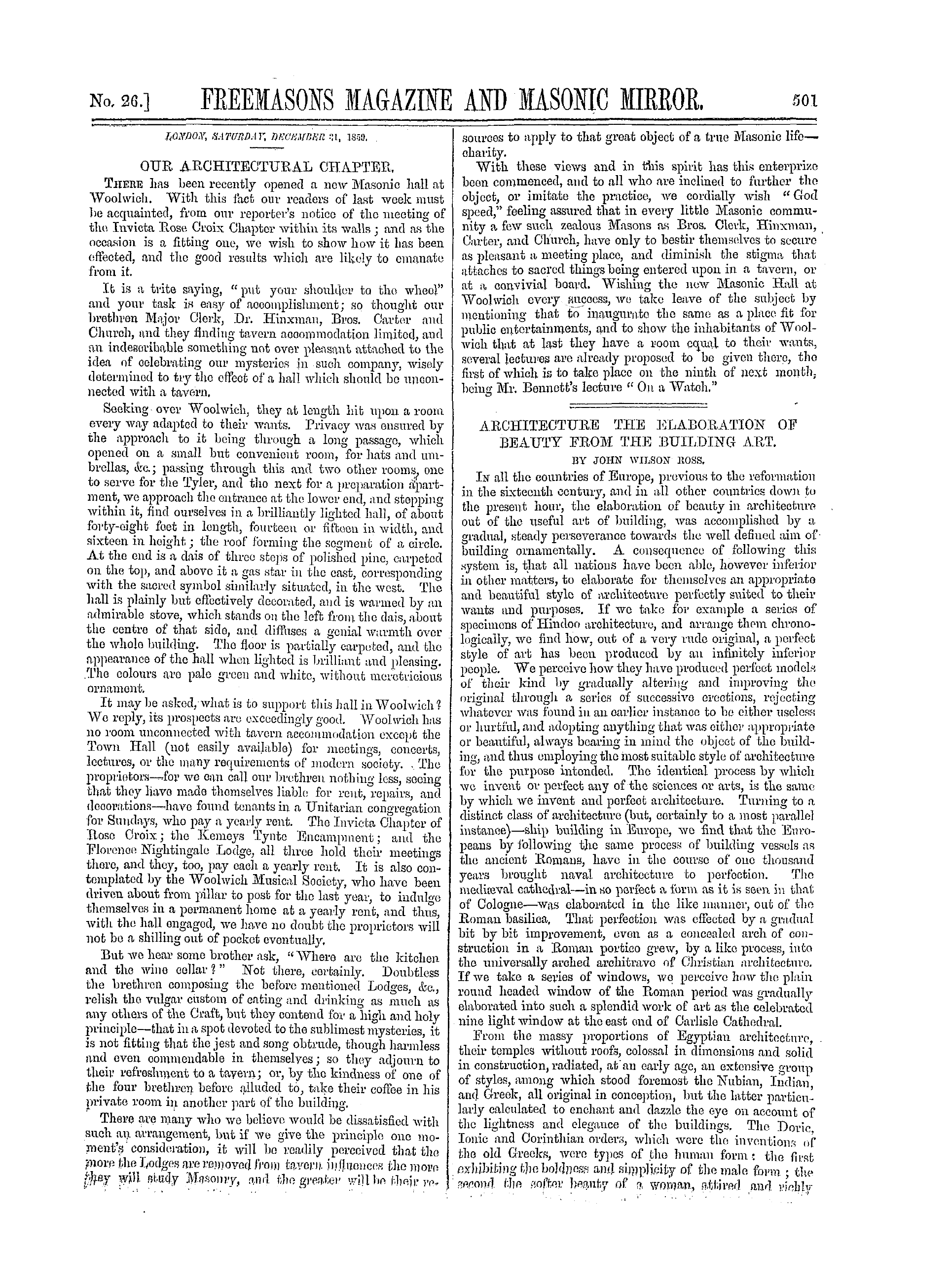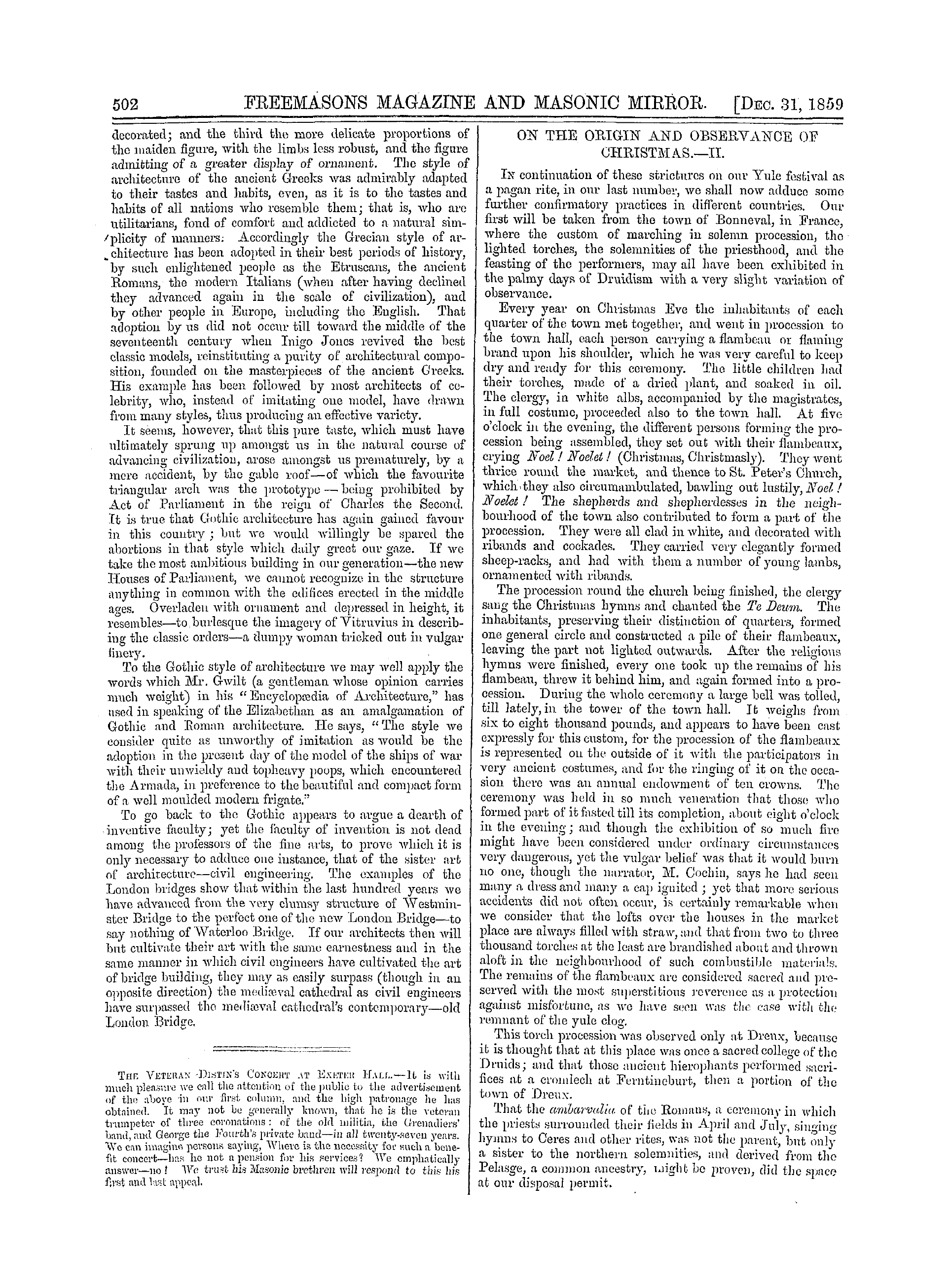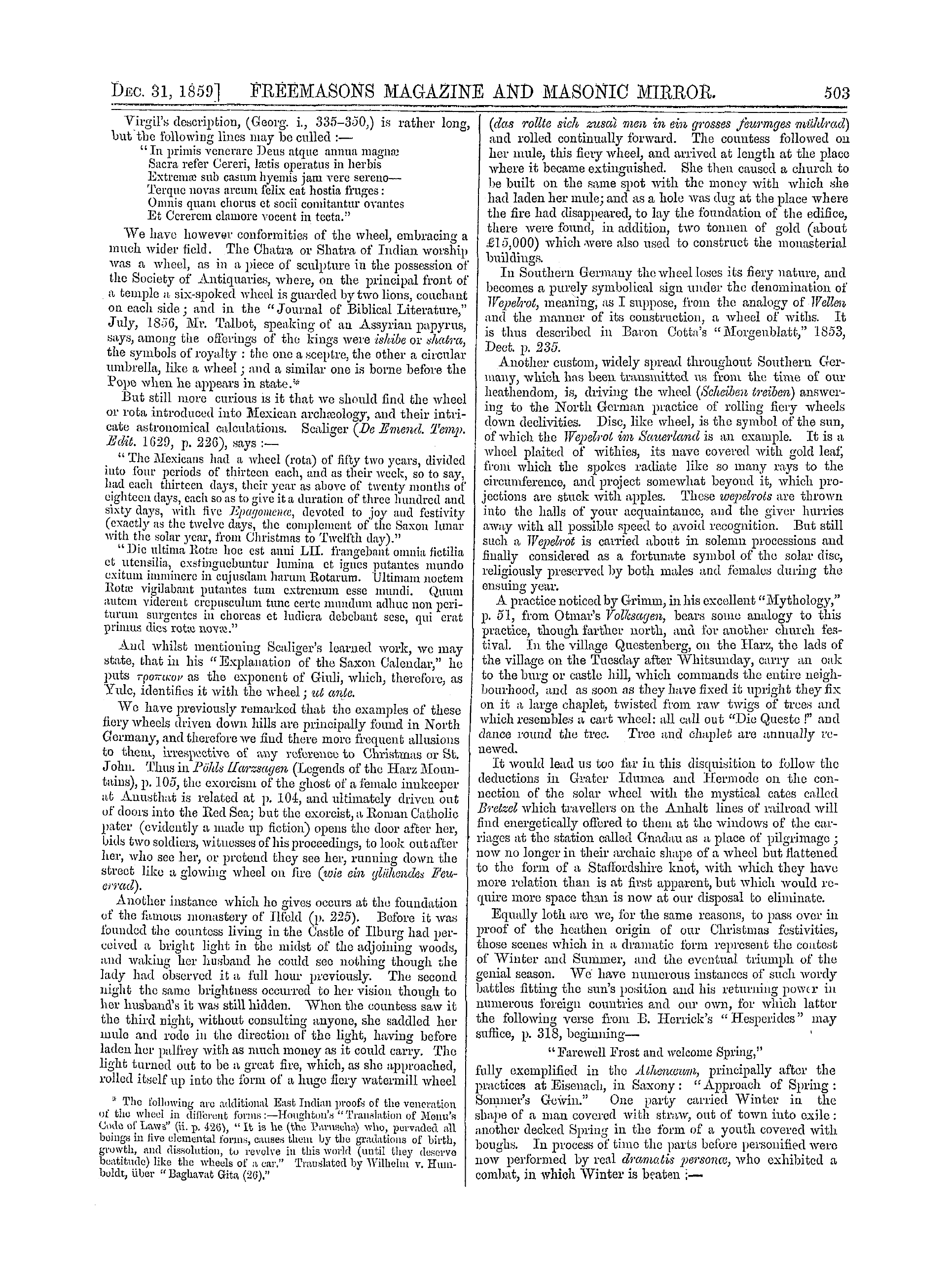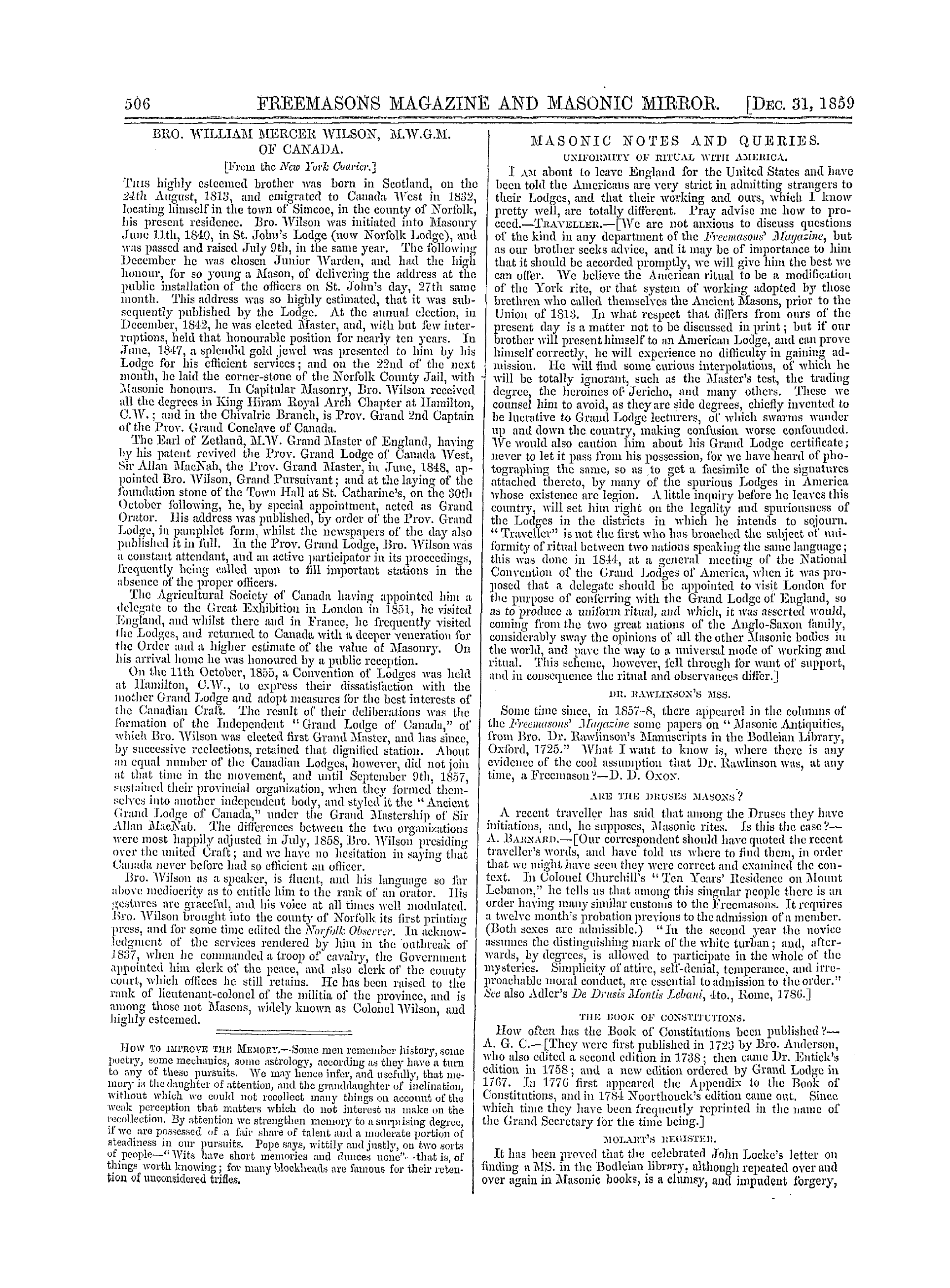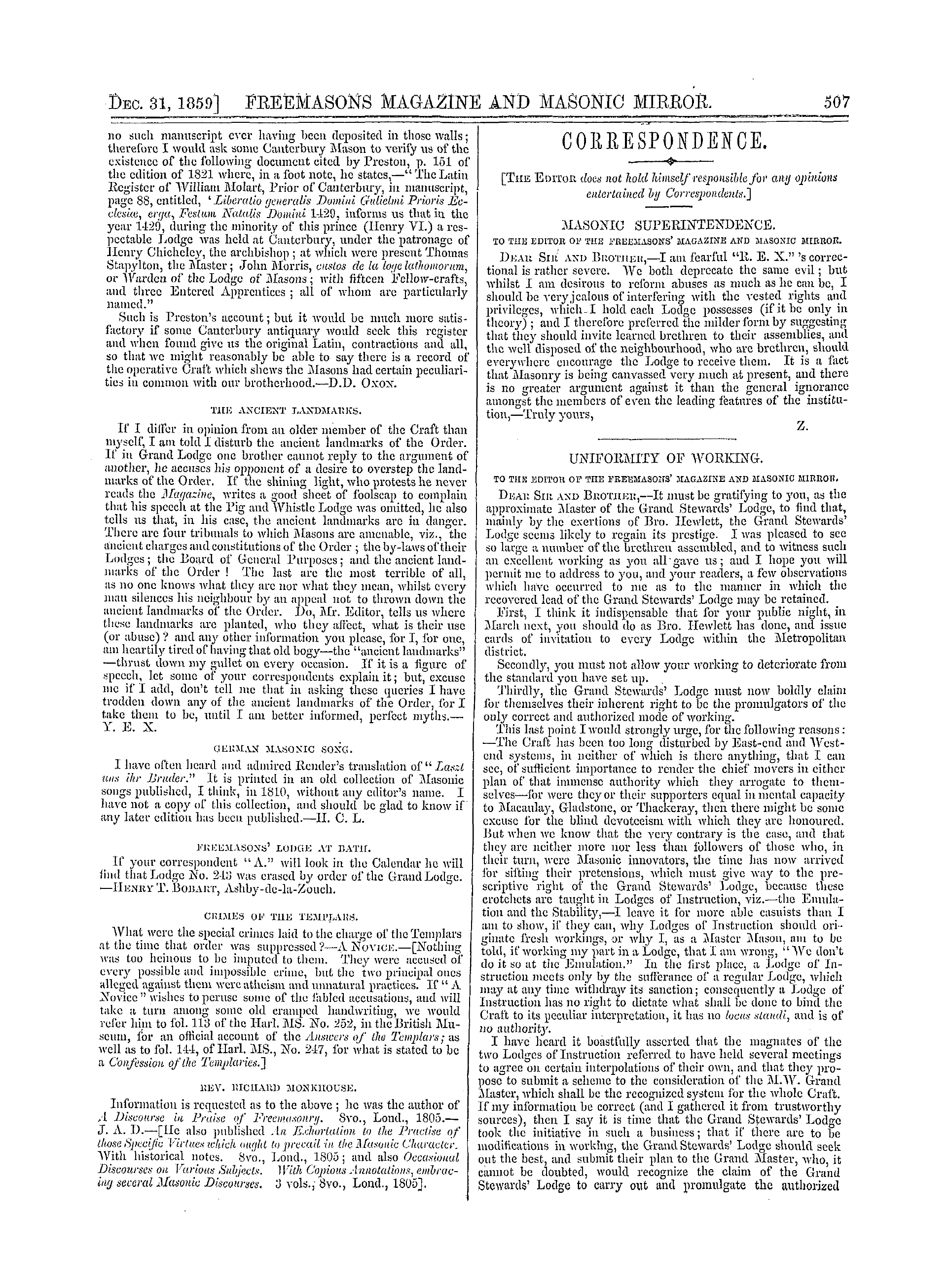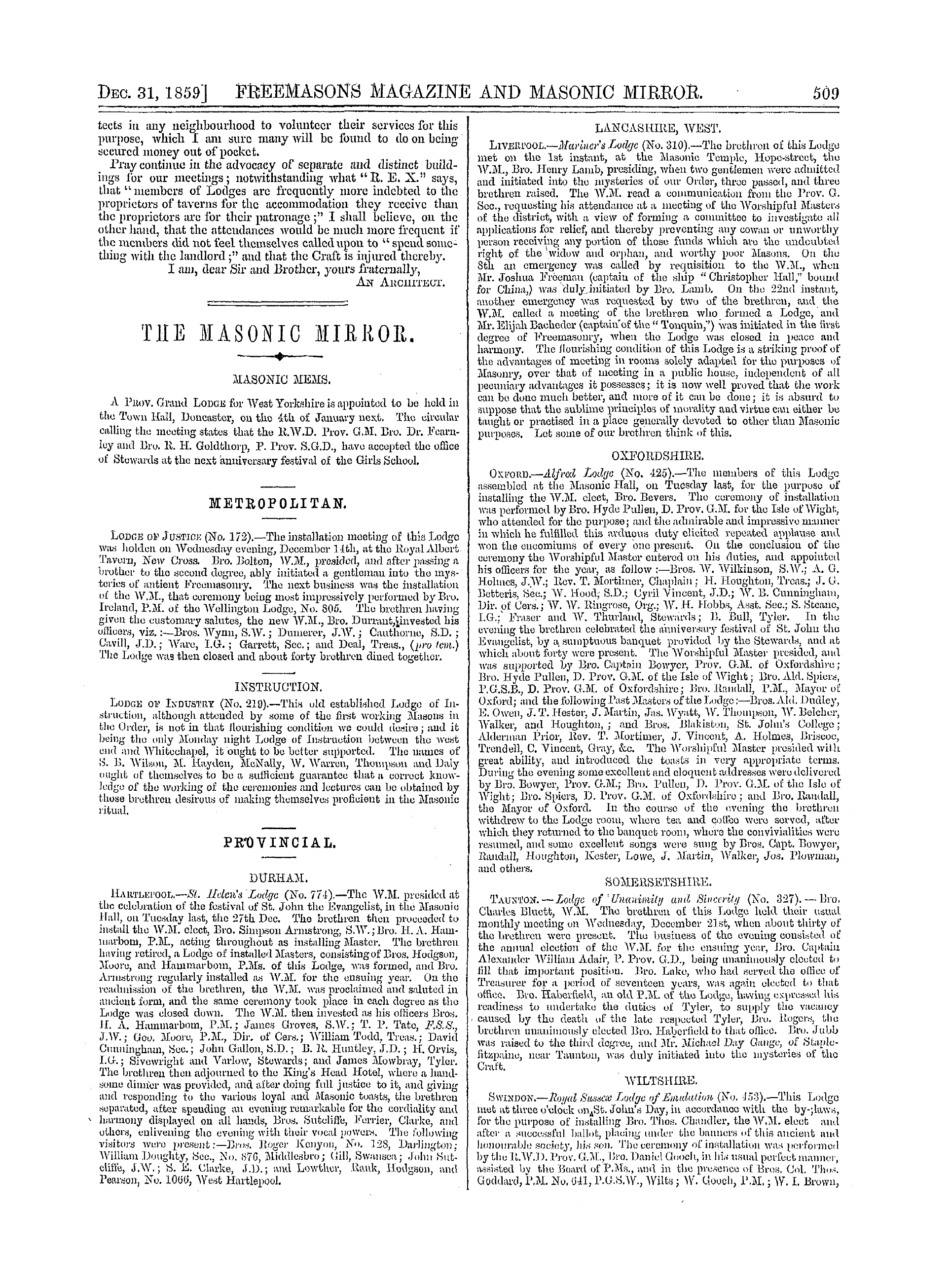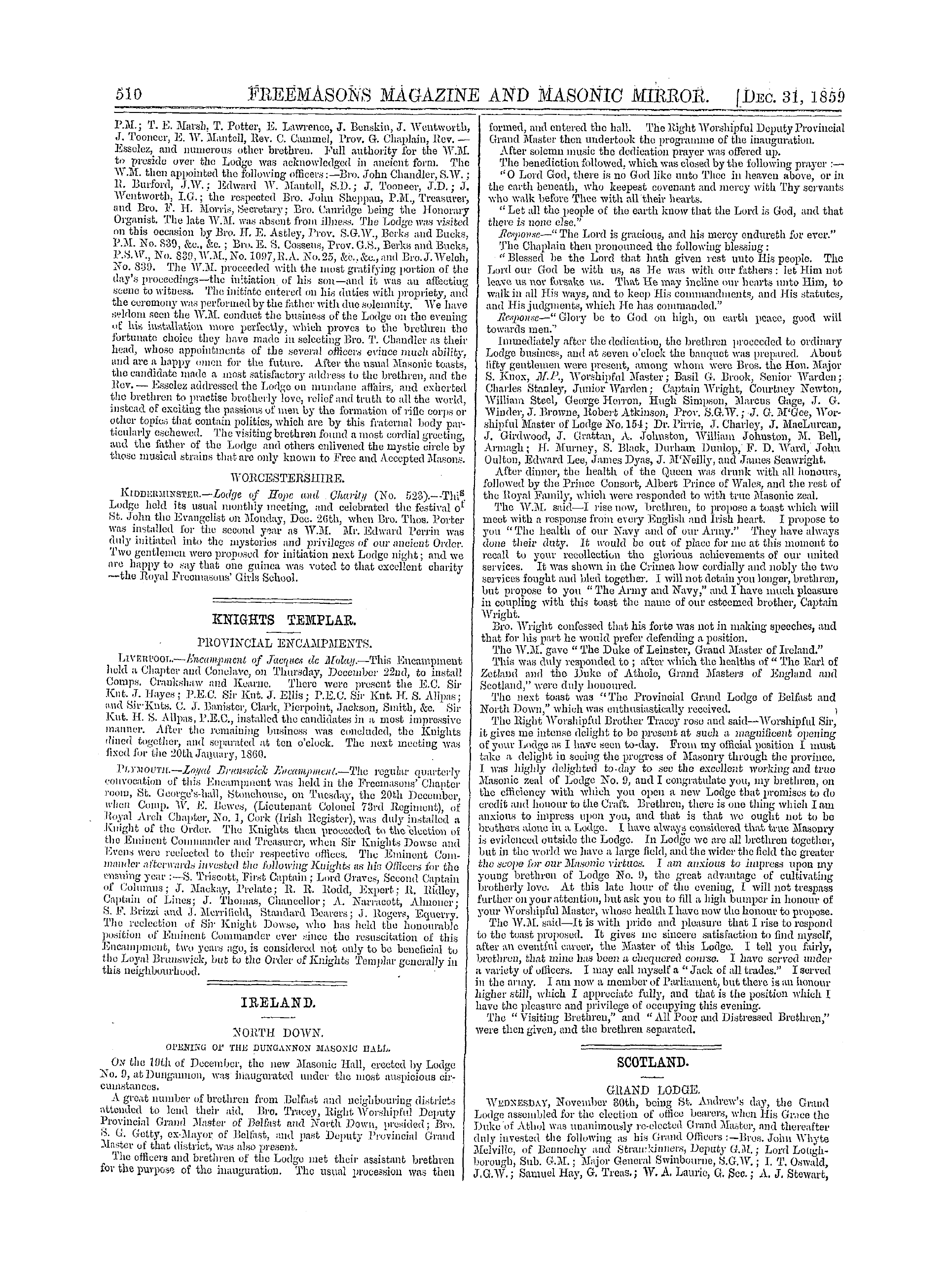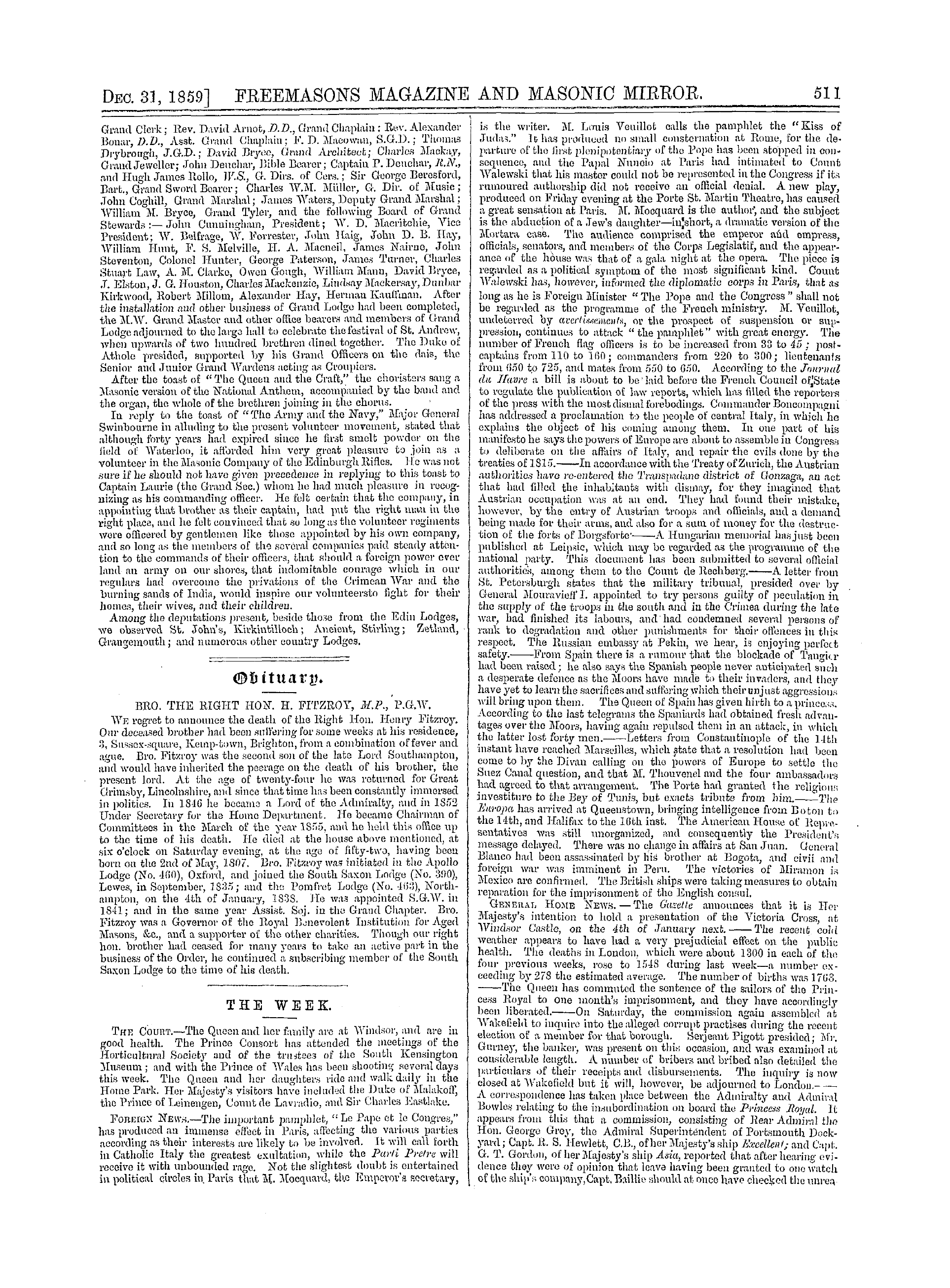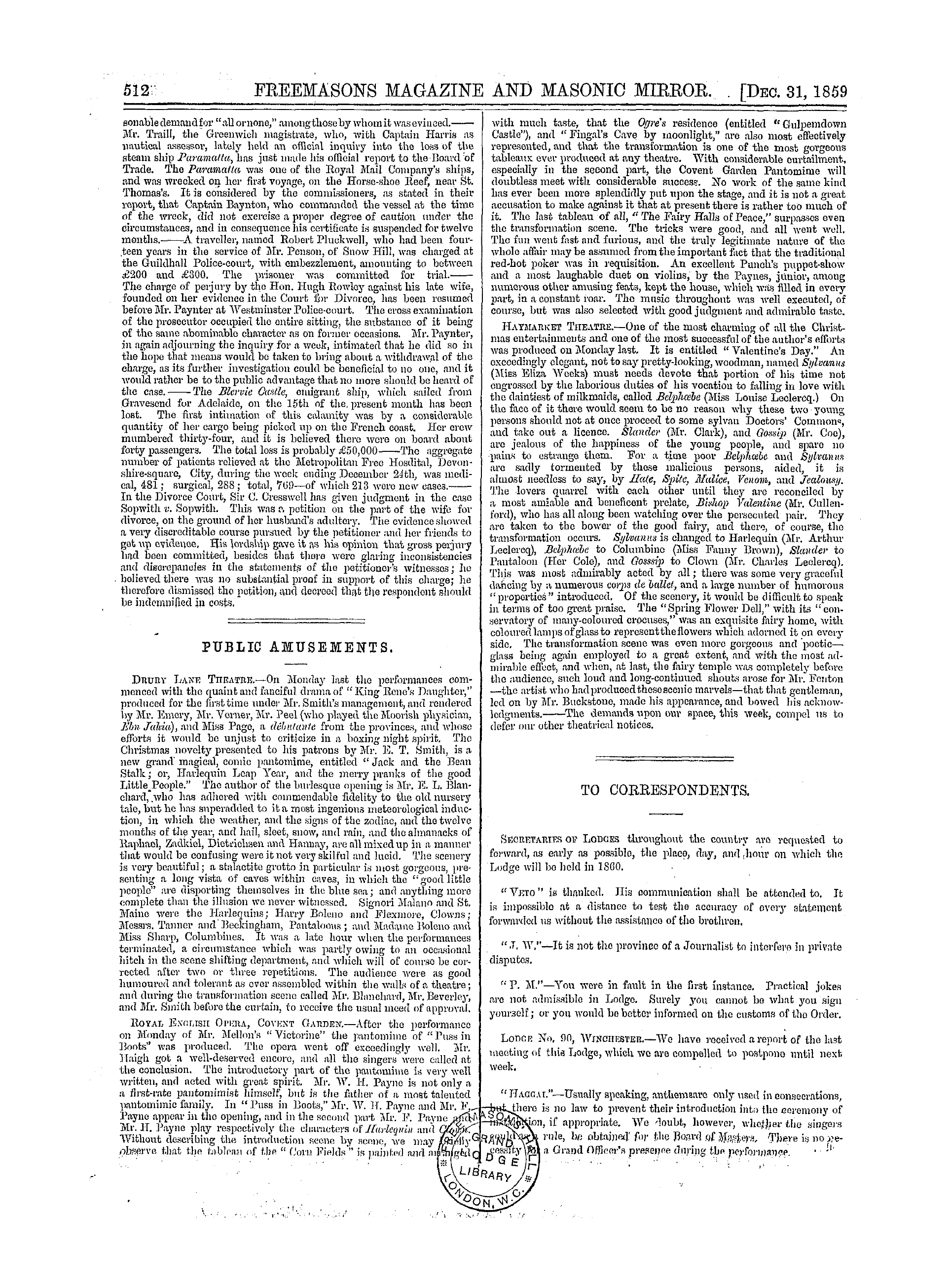Note: This text has been automatically extracted via Optical Character Recognition (OCR) software.
Architecture The Elaboration Of Beauty From The Building Art.
decorated ; ancl the third the more delicate proportions of tho maiden figure , with the limbs less robust , ancl the figure admitting of a greater display of ornament . The style of architecture of the ancient Greeks was admirably adapted to their tastes and habits , even , as it is to the tastes and habits of all nations who resemble them ; that is , who aro
utilitarians , fond of comfort and addicted to a natural sim-• ' p licity of manners : Accordingly the Grecian style of arc hitecture has been adopted in their best periods of history , by such enlightened people as the Etruscans , the ancient Romans , the modern Italians ( when after having declined they advanced again in the scale of civilization ) , ancl
by other people in Europe , including the English . That adoption by us did not occur till toward the middle of the seventeenth century when Inigo Jones revived the best classic models , reinstituting a purity of architectural composition , founded on the masterpieces of the ancient Greeks . His example has been followed by most architects of
celebrity , who , instead of imitating one model , have drawn from many styles , thus producing an effective variety . It seems , however , that this pure taste , which must have ultimately sprung up amongst us in the natural course of advancing civilization , arose amongst us prematurely , by a mere accident , by tho gable roof—of which the favourite
triangular arch was the prototype — being prohibited by Act of Parliament in the reign of Charles the Second . It is true that Gothic architecture has again gained favour in this country ; but we would willingly be spared the abortions in that style whicli daily greet our gaze . If ive take the most ambitious building in our generation—the new
Houses of Parliament , we cannot recognize m the structure anything in common with the edifices erected in the middle ages . Overladen with ornament ancl depressed in hei ght , it resembles—to burlesque the imagery of Vitruvius in describing the classic orders—a dumpy woman tricked out in vulgar finery . To the Gothic style of architecture we may well apply the
words which Mr . Gwilt ( a gentleman whose opinion carries much weight ) in his "Encyclopaedia of Architecture , " has used in speaking of the Elizabethan as an amalgamation of Gothic and Roman architecture . He says , " The style we consider quite as unworthy of imitation as would be the adoption in the jiroseiit day of the model of the ships of war
with their unwieldy and tophcavy poops , which encountered the Armada , in preference to the beautiful ancl compact form of a well moulded modern frigate . " To go back to the Gothic appears to argue a dearth of inventive faculty ; yet the faculty of invention is not dead among the jn-ofessors of the fine artsto prove which it is
, only necessary to adduce one instance , that of the sister art of architecture—civil engineering . The examples of the London bridges show that within the last hundred years we have advanced from the very clumsy structure of Westminster Bridge to the perfect one of the new London Bridge—to say nothing of Waterloo Bridge . If our architects then will
but cultivate their art with the same earnestness and in the same manner in which civil engineers have cultivated the art of bridge building , they may as easily surpass ( though in an opposite direction ) the mediaeval cathedral as civil engineers have surpassed the mediteval cathedral ' s contemporary—old London Bridge ,
TflF . VuTIillAN -DlSTINS CONOliHT . \ T JiXKTKH H . U . I .. — It is with much pleasure we call the attention of the public to the advertisement of the above in our first column , and the high patronage he has obtained . It may not be generally known , that he is the veteran trumpeter of three coronations : of the old militia , the Grenadiers ' band , and George the Fourth ' s private baud—in all twenty-seven years . We can imagine persons saying , "Where is the necessity foe such a ' beneftt concert—has he not a pension for his services ? We einphatieally answer—no ! We trust his Masonic brethren will respond to this his first ancl last appeal .
On The Origin And Observance Of Christmas.—Ii.
ON THE ORIGIN AND OBSERVANCE OF CHRISTMAS . —II .
IN continuation of these strictures on our Yule festival as a pagan rite , in our last number , we shall now adduce some further confirmatory practices in different countries . Our first will be taken from the town of Bonneval , in France , where the custom of marching in solemn procession , the lighted torches , the solemnities of the priesthood , ancl the
feasting of the performers , may all have been exhibited in the palmy days of Druidism with a very slight variation of observance . Every year on Christinas Eve the inhabitants of each quarter of the town met together , and went in procession to the town halleach person carrying a flambeau or flaming
, brand upon his shoulder , which he was very careful to keep dry ancl ready for this ceremony . The little children had their torches , made of a dried plant , and soaked in oil . The clergy , iu white albs , accompanied by the magistrates , in full costume , proceeded also to the town hall . At five o ' clock in the evening , the different persons forming the
procession being assembled , they set out with their flambeaux , crying Noel ! Noelet 1 ( Christmas , Christmasly ) . They went thrice round the market , and thence to St . Peter ' s Church , which , they also circumambulated , bawling out lustil y , Noel ! Noelet ! The shepherds and shepherdesses in the neighbourhood of the town also contributed to form a part of the
procession . They were all clad in white , and decorated with ribands and cockades . They carried very elegantl y formed sheep-racks , ancl had with them a number of young lambs , ornamented with ribands .
The procession round the church being finished , the clergy sang the Christmas hymns and chanted the Te Deitm . The inhabitants , preserving their distinction of quarters , formed one general circle and constructed a pile of their flambeaux , leaving the part not lighted outwards . After the religious hymns were finished , every one took up the remains of his
flambeau , threw it behind him , ancl again formed into a procession . During the whole ceremony a large bell was tolled , till lately , in the tower of tho town hall . It weighs from six to ei ght thousand pounds , ancl appears to have been cast expressly for this custom , for the procession of the flambeaux is represented on the outside of it with the participators in
very ancient costumes , and for the ringing of it on the occasion there was an annual endowment of ten crowns . The ceremony was held in so much veneration that those who formed part of it fasted till its completion , about ei ght o ' clock in the evening ; and though the exhibition of so much fire might have been considered under ordinary circumstances
very dangerous , yet the vulgar belief was that it would burn no one , though the narrator , M . Cochin , says he had seen many a dress ancl many a cap ignited ; yet that more serious accidents did not often occur , is certainly remarkable when we consider that the lofts over the houses in the market place are always filled with strawand that from two to three
, thousand torches at the least are brandished about ancl thrown aloft in the nei ghbourhood of such combustible materials . The remains of the flambeaux arc considered sacred and preserved with the most superstitious reverence as a protection against misfortune , as ive have seen was the case with tin ? remnant of the yule clog .
This torch procession was observed only at Drenx , because it is thought that at this place was once a sacred college of tho Druids ; and that those ancient hierophants performed sacrifices at a cromlech at Ferntineburt , then a portion of the town of Drenx .
That the ambarvalki . of the Romans , a ceremony in which the priests surrounded their fields in April ancl Jul y , sin ^ iin ,-hymns to Ceres and other rites , was not the parent , but only a sister to the northern solemnities , and derived from the Pelasge , a common ancestry , might bo proven , did the space at our disposal permit .
Note: This text has been automatically extracted via Optical Character Recognition (OCR) software.
Architecture The Elaboration Of Beauty From The Building Art.
decorated ; ancl the third the more delicate proportions of tho maiden figure , with the limbs less robust , ancl the figure admitting of a greater display of ornament . The style of architecture of the ancient Greeks was admirably adapted to their tastes and habits , even , as it is to the tastes and habits of all nations who resemble them ; that is , who aro
utilitarians , fond of comfort and addicted to a natural sim-• ' p licity of manners : Accordingly the Grecian style of arc hitecture has been adopted in their best periods of history , by such enlightened people as the Etruscans , the ancient Romans , the modern Italians ( when after having declined they advanced again in the scale of civilization ) , ancl
by other people in Europe , including the English . That adoption by us did not occur till toward the middle of the seventeenth century when Inigo Jones revived the best classic models , reinstituting a purity of architectural composition , founded on the masterpieces of the ancient Greeks . His example has been followed by most architects of
celebrity , who , instead of imitating one model , have drawn from many styles , thus producing an effective variety . It seems , however , that this pure taste , which must have ultimately sprung up amongst us in the natural course of advancing civilization , arose amongst us prematurely , by a mere accident , by tho gable roof—of which the favourite
triangular arch was the prototype — being prohibited by Act of Parliament in the reign of Charles the Second . It is true that Gothic architecture has again gained favour in this country ; but we would willingly be spared the abortions in that style whicli daily greet our gaze . If ive take the most ambitious building in our generation—the new
Houses of Parliament , we cannot recognize m the structure anything in common with the edifices erected in the middle ages . Overladen with ornament ancl depressed in hei ght , it resembles—to burlesque the imagery of Vitruvius in describing the classic orders—a dumpy woman tricked out in vulgar finery . To the Gothic style of architecture we may well apply the
words which Mr . Gwilt ( a gentleman whose opinion carries much weight ) in his "Encyclopaedia of Architecture , " has used in speaking of the Elizabethan as an amalgamation of Gothic and Roman architecture . He says , " The style we consider quite as unworthy of imitation as would be the adoption in the jiroseiit day of the model of the ships of war
with their unwieldy and tophcavy poops , which encountered the Armada , in preference to the beautiful ancl compact form of a well moulded modern frigate . " To go back to the Gothic appears to argue a dearth of inventive faculty ; yet the faculty of invention is not dead among the jn-ofessors of the fine artsto prove which it is
, only necessary to adduce one instance , that of the sister art of architecture—civil engineering . The examples of the London bridges show that within the last hundred years we have advanced from the very clumsy structure of Westminster Bridge to the perfect one of the new London Bridge—to say nothing of Waterloo Bridge . If our architects then will
but cultivate their art with the same earnestness and in the same manner in which civil engineers have cultivated the art of bridge building , they may as easily surpass ( though in an opposite direction ) the mediaeval cathedral as civil engineers have surpassed the mediteval cathedral ' s contemporary—old London Bridge ,
TflF . VuTIillAN -DlSTINS CONOliHT . \ T JiXKTKH H . U . I .. — It is with much pleasure we call the attention of the public to the advertisement of the above in our first column , and the high patronage he has obtained . It may not be generally known , that he is the veteran trumpeter of three coronations : of the old militia , the Grenadiers ' band , and George the Fourth ' s private baud—in all twenty-seven years . We can imagine persons saying , "Where is the necessity foe such a ' beneftt concert—has he not a pension for his services ? We einphatieally answer—no ! We trust his Masonic brethren will respond to this his first ancl last appeal .
On The Origin And Observance Of Christmas.—Ii.
ON THE ORIGIN AND OBSERVANCE OF CHRISTMAS . —II .
IN continuation of these strictures on our Yule festival as a pagan rite , in our last number , we shall now adduce some further confirmatory practices in different countries . Our first will be taken from the town of Bonneval , in France , where the custom of marching in solemn procession , the lighted torches , the solemnities of the priesthood , ancl the
feasting of the performers , may all have been exhibited in the palmy days of Druidism with a very slight variation of observance . Every year on Christinas Eve the inhabitants of each quarter of the town met together , and went in procession to the town halleach person carrying a flambeau or flaming
, brand upon his shoulder , which he was very careful to keep dry ancl ready for this ceremony . The little children had their torches , made of a dried plant , and soaked in oil . The clergy , iu white albs , accompanied by the magistrates , in full costume , proceeded also to the town hall . At five o ' clock in the evening , the different persons forming the
procession being assembled , they set out with their flambeaux , crying Noel ! Noelet 1 ( Christmas , Christmasly ) . They went thrice round the market , and thence to St . Peter ' s Church , which , they also circumambulated , bawling out lustil y , Noel ! Noelet ! The shepherds and shepherdesses in the neighbourhood of the town also contributed to form a part of the
procession . They were all clad in white , and decorated with ribands and cockades . They carried very elegantl y formed sheep-racks , ancl had with them a number of young lambs , ornamented with ribands .
The procession round the church being finished , the clergy sang the Christmas hymns and chanted the Te Deitm . The inhabitants , preserving their distinction of quarters , formed one general circle and constructed a pile of their flambeaux , leaving the part not lighted outwards . After the religious hymns were finished , every one took up the remains of his
flambeau , threw it behind him , ancl again formed into a procession . During the whole ceremony a large bell was tolled , till lately , in the tower of tho town hall . It weighs from six to ei ght thousand pounds , ancl appears to have been cast expressly for this custom , for the procession of the flambeaux is represented on the outside of it with the participators in
very ancient costumes , and for the ringing of it on the occasion there was an annual endowment of ten crowns . The ceremony was held in so much veneration that those who formed part of it fasted till its completion , about ei ght o ' clock in the evening ; and though the exhibition of so much fire might have been considered under ordinary circumstances
very dangerous , yet the vulgar belief was that it would burn no one , though the narrator , M . Cochin , says he had seen many a dress ancl many a cap ignited ; yet that more serious accidents did not often occur , is certainly remarkable when we consider that the lofts over the houses in the market place are always filled with strawand that from two to three
, thousand torches at the least are brandished about ancl thrown aloft in the nei ghbourhood of such combustible materials . The remains of the flambeaux arc considered sacred and preserved with the most superstitious reverence as a protection against misfortune , as ive have seen was the case with tin ? remnant of the yule clog .
This torch procession was observed only at Drenx , because it is thought that at this place was once a sacred college of tho Druids ; and that those ancient hierophants performed sacrifices at a cromlech at Ferntineburt , then a portion of the town of Drenx .
That the ambarvalki . of the Romans , a ceremony in which the priests surrounded their fields in April ancl Jul y , sin ^ iin ,-hymns to Ceres and other rites , was not the parent , but only a sister to the northern solemnities , and derived from the Pelasge , a common ancestry , might bo proven , did the space at our disposal permit .
